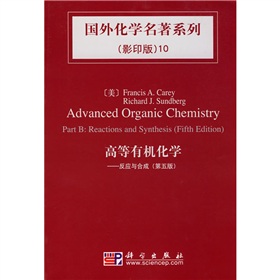国外化学名著系列10·高等有机化学:反应与合成 电子书下载 PDF下载

内容简介
《高等有机化学:反应与合成(第5版)》是《高等有机化学:反应与合成(第5版)》的新版,自从1977年面世以来,《高等有机化学:反应与合成(第5版)》作为学科首选教材的地位一直没有动摇过,广泛地覆盖了有机化合物的结构、反应活性及合成。她的第五版相对2001年出版的第四版进行了大幅度的修订,更新了学科发展的相关资料,内容组织更加清晰明朗,特别是计算化学部分。通过控制反应而得到特定的合成是有机合成的全部目标。PartB在不同反应类型的基础上详尽地描述了最常见的和最有用的合成反应。每章后附有习题精选及解答习题的推荐参考文献。
·查看全部>>
目录
Preface
Acknowledgment and Personal Statement
Introduction
Chapter 1. Alkylation of Enolates and Other Carbon Nucleophiles
Introduction
1.1. Generation and Properties of Enolates and Other Stabilized Carbanions
1.1.1. Generation of Enolates by Deprotonation
1.1.2. Regioselectivity and Stereoselectivity in Enolate Formation from Ketones and Esters
1.1.3. Other Means of Generating Enolates
1.1.4. Solvent Effects on Enolate Structure and Reactivity
1.2. Alkylation of Enolates
1.2.1. Alkylation of Highly Stabilized Enolates
1.2.2. Alkylation of Ketone Enolates
1.2.3. Alkylation of Aldehydes, Esters, Carboxylic Acids, Amides, and Nitriles
1.2.4. Generation and Alkylation of Dianions
1.2.5. Intramolecular Alkylation of Enolates
1.2.6. Control of Enantioselectivity in Alkylation Reac:ions
1.3. The Nitrogen Analogs of Enols and Enolates: Enamines and Imine Anions
General References
Problems
Chapter 2. Reactions of Carbon Nucleophiles with Carbonyl Compounds
Introduction
2.1. Aldol Addition and Condensation Reactions
2.1.1. The General Mechanism
2.1.2. Control of Regio- and Stereoselectivity of Aldol Reactions of Aldehydes and Ketones
2.1.3. Aldol Addition Reactions of Enolates of Esters and Other Carbonyl Derivatives
2.1.4. The Mukaiyama Aldol Reaction
2.1.5. Control of Facial Selectivity in Aldol and Mukaiyama Aldol Reactions
2.1.6. Intramolecular Aldol Reactions and the Robinson Annulation
2.2. Addition Reactions of Imines and Iminium Ions
2.2.1. The Mannich Reaction
2.2.2. Additions to N-Acyl Iminium Ions
2.2.3. Amine-Catalyzed Condensation Reactions
2.3. Acylation of Carbon Nucleophiles
2.3.1. Claisen and Dieckmann Condensation Reactions
2.3.2. Acylation of Enolates and Other Carbon Nucleophiles
2.4. Olefination Reactions of Stabilized Carbon Nucleophiles
2.4.1. The Wittig and Related Reactions of Phosphorus-Stabilized Carbon Nucleophiles
2.4.2. Reactions of a-Trimethyisilylcarbanions with Carbonyl Compounds
2.4.3. The Julia Olefination Reaction
2.5. Reactions Proceeding by Addition-Cyclization
2.5.1. Sulfur Yiides and Related Nucleophiles
2.5.2. Nucleophilic Addition-Cyclization of ot-Haloesters
2.6. Conjugate Addition by Carbon Nucleophiles
2.6.1. Conjugate Addition of Enolates
2.6.2. Conjugate Addition with Tandem Alkylation
2.6.3. Conjugate Addition by Enolate Equivalents
2.6.4. Control of Facial Selectivity in Conjugate Addition Reactions
2.6.5. Conjugate Addition of Organometallic Reagents
2.6.6. Conjugate Addition of Cyanide Ion
General References
Problems
Chapter 3. Functional Group Interconversion by Substitution, Including Protection and Deprotection
Introduction
3.1. Conversion of Alcohols to Alkylating Agents
3.1.1. Sulfonate Esters
3.1.2. Halides
……
Chapter 4. Electrophilic Additions to Carbon-Carbon Multiple Bonds
Chapter 5. Reduction of Carbon-Carbon Multiple Bonds, Carbonyl Croups, and Other Functional Groups
Chapter 6. Concerted Cycloadditions, Unimolecular Rearrangements, and Thermal Eliminations
Chapter 7. Organometallic Compounds of Group I and II Metals
Chapter 8. Reactions Involving Transition Metals
Chapter 9. Carbon-Carbon Bond-Forming Reactions of Compounds of Boron, Silcon, and Tin
Chapter 10. Reactions Involving Carbocations, Carbenes, and Radicals and Reactive Intermediates
Chapter 11. Aromatic Substitution Reactions
Chapter 12. Oxidations
Chapter 13. Multistep Syntheses
References
Index
Acknowledgment and Personal Statement
Introduction
Chapter 1. Alkylation of Enolates and Other Carbon Nucleophiles
Introduction
1.1. Generation and Properties of Enolates and Other Stabilized Carbanions
1.1.1. Generation of Enolates by Deprotonation
1.1.2. Regioselectivity and Stereoselectivity in Enolate Formation from Ketones and Esters
1.1.3. Other Means of Generating Enolates
1.1.4. Solvent Effects on Enolate Structure and Reactivity
1.2. Alkylation of Enolates
1.2.1. Alkylation of Highly Stabilized Enolates
1.2.2. Alkylation of Ketone Enolates
1.2.3. Alkylation of Aldehydes, Esters, Carboxylic Acids, Amides, and Nitriles
1.2.4. Generation and Alkylation of Dianions
1.2.5. Intramolecular Alkylation of Enolates
1.2.6. Control of Enantioselectivity in Alkylation Reac:ions
1.3. The Nitrogen Analogs of Enols and Enolates: Enamines and Imine Anions
General References
Problems
Chapter 2. Reactions of Carbon Nucleophiles with Carbonyl Compounds
Introduction
2.1. Aldol Addition and Condensation Reactions
2.1.1. The General Mechanism
2.1.2. Control of Regio- and Stereoselectivity of Aldol Reactions of Aldehydes and Ketones
2.1.3. Aldol Addition Reactions of Enolates of Esters and Other Carbonyl Derivatives
2.1.4. The Mukaiyama Aldol Reaction
2.1.5. Control of Facial Selectivity in Aldol and Mukaiyama Aldol Reactions
2.1.6. Intramolecular Aldol Reactions and the Robinson Annulation
2.2. Addition Reactions of Imines and Iminium Ions
2.2.1. The Mannich Reaction
2.2.2. Additions to N-Acyl Iminium Ions
2.2.3. Amine-Catalyzed Condensation Reactions
2.3. Acylation of Carbon Nucleophiles
2.3.1. Claisen and Dieckmann Condensation Reactions
2.3.2. Acylation of Enolates and Other Carbon Nucleophiles
2.4. Olefination Reactions of Stabilized Carbon Nucleophiles
2.4.1. The Wittig and Related Reactions of Phosphorus-Stabilized Carbon Nucleophiles
2.4.2. Reactions of a-Trimethyisilylcarbanions with Carbonyl Compounds
2.4.3. The Julia Olefination Reaction
2.5. Reactions Proceeding by Addition-Cyclization
2.5.1. Sulfur Yiides and Related Nucleophiles
2.5.2. Nucleophilic Addition-Cyclization of ot-Haloesters
2.6. Conjugate Addition by Carbon Nucleophiles
2.6.1. Conjugate Addition of Enolates
2.6.2. Conjugate Addition with Tandem Alkylation
2.6.3. Conjugate Addition by Enolate Equivalents
2.6.4. Control of Facial Selectivity in Conjugate Addition Reactions
2.6.5. Conjugate Addition of Organometallic Reagents
2.6.6. Conjugate Addition of Cyanide Ion
General References
Problems
Chapter 3. Functional Group Interconversion by Substitution, Including Protection and Deprotection
Introduction
3.1. Conversion of Alcohols to Alkylating Agents
3.1.1. Sulfonate Esters
3.1.2. Halides
……
Chapter 4. Electrophilic Additions to Carbon-Carbon Multiple Bonds
Chapter 5. Reduction of Carbon-Carbon Multiple Bonds, Carbonyl Croups, and Other Functional Groups
Chapter 6. Concerted Cycloadditions, Unimolecular Rearrangements, and Thermal Eliminations
Chapter 7. Organometallic Compounds of Group I and II Metals
Chapter 8. Reactions Involving Transition Metals
Chapter 9. Carbon-Carbon Bond-Forming Reactions of Compounds of Boron, Silcon, and Tin
Chapter 10. Reactions Involving Carbocations, Carbenes, and Radicals and Reactive Intermediates
Chapter 11. Aromatic Substitution Reactions
Chapter 12. Oxidations
Chapter 13. Multistep Syntheses
References
Index
同类热门电子书下载更多
Copyright © 2025 by topbester.com.
All Rights Reserved.
沪ICP备14027842号-1
All Rights Reserved.
沪ICP备14027842号-1